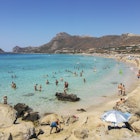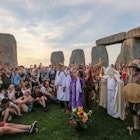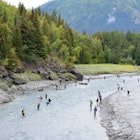
Explore Alaska on the the cheap with these 10 epic experiences

Sep 17, 2021 • 6 min read

A state known as much for its high prices as its epic experiences, Alaska doesn't have to break the budget © Galyna Andrushko / Shutterstock
Alaska ain’t cheap, as any "sourdough" (old-timer) will tell you. The cost of flying and shipping everything to such an isolated region is invariably passed on to the consumer.
But if you’re willing to forsake flightseeing for hiking and national museums for national parks, you’re halfway to experiencing the US’s largest state on a shoestring.

Enjoy the outdoors at these eight national parks and preserves
In contrast to many national parks in the Lower 48, seven of Alaska’s eight parks and preserves don’t charge entrance fees. All of Wrangell-St Elias (a park the size of Switzerland) is free to roam at no cost. The full eight million acres of Gates of the Arctic can be enjoyed for nothing.
The only Alaskan national park where you do have to dip into your wallet is Denali which charges an affordable $15 (valid for seven days).
There are caveats, of course. Getting to some of the state’s more remote parks can be pricey. For a cheap intro, try Kenai Fjords National Park whose marquee sight, the Exit Glacier, is easily accessible from the town of Seward. Rangers at the Exit Glacier Nature Center lead free one-hour hikes to the ice-flow, imparting information on the wildlife and natural history of the area on the way.
When is the best time to go to Alaska?

Learn about the Tlingit at the Sitka National Historical Park
This striking juxtaposition of Indigenous totem poles and Russian colonial culture explores a little-known chapter of Alaskan history on the site where native Tlingits were defeated by the Russians in 1804.
A beguiling one-mile-long forest walk weaves past 18 Tlingit and Haida totem poles that blend seamlessly with the shadowy trees; most of the structures are over 100 years old. The path also crosses the site of an old Tlingit fort, the last bastion in a key face-off between the Russians and the Indigenous people. The story of the 1804 battle is re-told at the park visitor center also home to a wood-carving workshop where you can watch local artists at work.
The nearby Russian Bishop’s House includes an ornate Orthodox chapel and was constructed by Finnish craftsmen in 1843. It is one of the few remaining examples of Russian colonial architecture in the Western hemisphere and one of the oldest buildings in Alaska.

Feel the chill at the Mendenhall Glacier Visitor Center
A day out at the Mendenhall Glacier costs nothing but the bus fare from Juneau ($2) if you head directly to the waterside visitor center with its giant glass windows and full-frontal view of the calving ice-flow abutting Mendenhall Lake.
The center doubles up as a mini museum with geological exhibits complemented by a beautifully shot film about the relationship between glaciers, wildlife and people. It’s also the nexus for a lattice of short trails (pick up a free map) that meander to various viewpoints and get you to within showering distance of thundering Nugget Falls. If you’re lucky, you even might spot a bear or two (at a safe distance) at no extra cost.

Hitch a ride on the Mt Roberts Tramway
Most tourists ascend Juneau’s Mt Roberts on its spectacular tramway (cable car) that leaves directly from the cruise ship dock. On reaching the summit, there’s time for lunch in the ridge-top restaurant followed by a couple of short strolls above the treeline before taking the tramway back to town. Total price: an exorbitant $35, plus the food.
For those on tighter budgets, there’s a cheaper alternative. Hike up to the tramway’s top station on a steep two-mile trail, spend $10 in the restaurant and ride back down for free. It’s a fun dollar-saving day out that’s well worth the energy expenditure.
Go on an art crawl of Seward’s murals
Alaska’s street art capital isn’t metro Anchorage or even capital Juneau, but the village-sized city of Seward. A total of 35 story-telling murals painted by local artists makes up a huge outdoor art gallery that draws heavily on Alaskan and Sewardian themes.
There are tributes to the famous Mt Marathon race, depictions of hardworking fishers, nods to brave bush pilots and a shout-out to the legendary Iditarod dog-sledding event. The project was initiated in 1999 and includes work from 20 different artists.
The 10 best day trips from Anchorage

Tour Skagway’s historic Klondike gold rush sites
Look past the cruise-ship day-trippers, a million of whom disgorge onto Skagway’s creaky boardwalks every summer, and you’ll see a wonderful town-sized museum haunted by the ghosts of the 1898 Klondike gold rush and all the brothels, gunfights and debauchery that went with it.
Most of Skagway’s historic buildings are managed by the National Park Service and the best of them – including the Moore Homestead, the Mascot Saloon, and the wonderful visitor center turned museum – don’t charge for entry. Equally gratis are the street actors, waitstaff in period costume and storytelling national park rangers who enliven the bars and boardwalks around town.
Dive in and join the (free) show.
Admire Indigenous art at the Maxine & Jesse Whitney Museum
This enlightening museum in diminutive Valdez on Prince William Sound isn’t just free to enter (unusual in Alaska), it’s also one of the best of its kind in the state. The artifacts, which are legion and varied, were donated from the private collection of an American couple who relocated to Alaska in 1947 and became enthusiastic hoarders of indigenous art, random ephemera, and taxidermy.
Kudos should go to the curation which has organized the mass of objects in a coherent and interesting way with written commentaries that discuss and examine rather than evangelize. Admire model ships, fish wheels, moose-antler furniture, native masks, and lifelike stuffed animals.

Honor the dead at Totem Bight State Park
Totem poles are ubiquitous in southeast Alaska where they have been sculpted for centuries by Haida, Tlingit and Tsimshian people. One of the best places to learn about their role in greeting visitors, honoring the dead, burying deceased ancestors and shaming transgressors is at Totem Bight State Park, 10 miles north of downtown Ketchikan.
The partly forested 33-acre park overlooking the Tongass Narrows serves as a free outdoor totem museum with 14 poles and an intricately carved clan house adorned with ravens, whales, and other native motifs.
Detailed interpretive boards explain the importance of the poles, all of which are replicas made in the 1930s during an early attempt to revive the then dying art of totem carving.
Stroll the Kennecott Mines National Historic Landmark
In one of the few road-accessible corners of mammoth Wrangell-St Elias National Park, this once flourishing copper mine is now a noble ruin and a roughshod outdoor museum to boot.
You can stroll at will around the mishmash of antique industrial buildings, some restored (such as the Depression-era General Store), others left in a state of ghostly decrepitude. For the full story of Kennecott’s brief reign as a prosperous mining community, join one of the free ranger-led walks that depart daily from the visitor center between May and September.

Go for a hike
Once you’ve invested in the essential gear – durable footwear, bear spray, walking poles and the like – Alaska’s finest and most widely available activity works out absurdly cheap. Whether you’re body-swerving hand-holding couples on the paved Tony Knowles Coastal Trail in Anchorage or dodging grizzles in the treeless (and trail-less) taiga of Denali National Park, hiking in the "Last Frontier" is nearly always free. The iconic Chilkoot Trail, which crosses into Canada, is one of the few trails that charges a fee.
Even multi-day hikers make savings, backcountry camping is free in all of Alaska’s national parks (although in Denali you’ll need to apply for a permit).
You might also like:
Travelers to Alaska can get a free COVID-19 vaccination
Top 8 road trips in Alaska
Why Alaska's stunning coast is best seen by ferry
This article was originally published in June 2021 and updated in September 2021.
Explore related stories







 National Parks4 Alaska itineraries that are made for spectacular summer adventures
National Parks4 Alaska itineraries that are made for spectacular summer adventuresMay 27, 2024 • 7 min read


